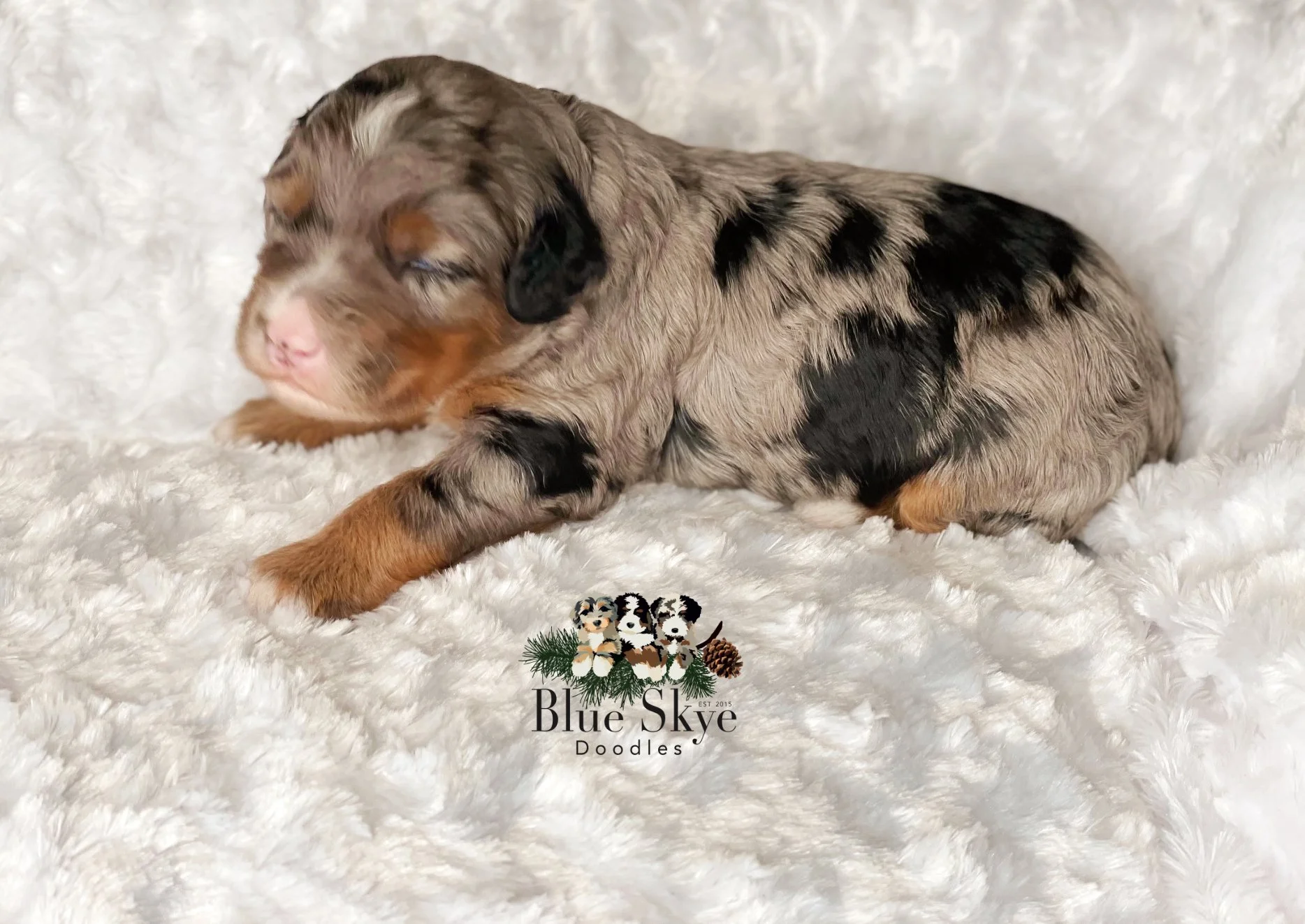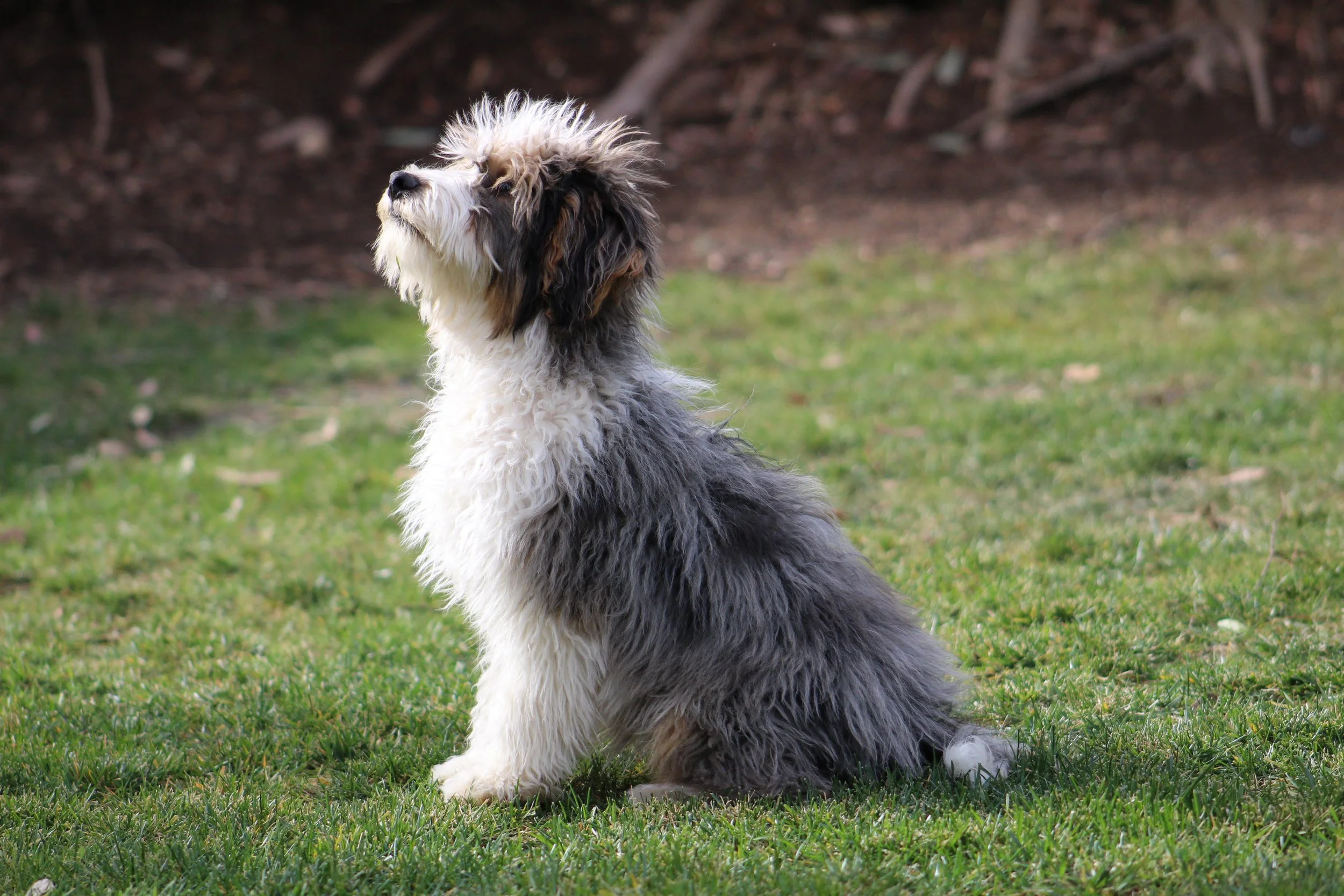
Bernedoodle & Australian Mountain Doodle Colors, Coats & the Merle Pattern
Doodle Colors
One of my favorite things about Doodle’s is their kaleidoscope of colors. Variety in colors, patterns and even textures, there is something for everyone. While most people associate a red/blonde color with a Golden Retriever and black tricolor with a Bernese Mountain Dog, the poodle side of your doodle, genetically makes for many possibilities.
Poodles come in many colors - black, blue, apricot, chocolate, cream, red, silver, silver beige, blonde, white, gray, sable and cafe au lait. There are also many patterns like parti, tuxedo, abstract, brindle and merle. All complicated by dominant as well as recessive genes, allowing for two gray or black parents to produce an apricot or brown puppy, if they each carry one gene for that color.
When we say Tricolor, we are referring to three colors (typically a body color like black, chocolate or a merle pattern) along with white (muzzle, head, chest and/or paws) and copper “points” (on cheeks, eyebrows, hocks, legs and under the tail). Bi-Color refers to only two colors - a body color of black, chocolate or red/apricot/blonde and white (usually on the paws, chest and face). Note that the red/apricot/blonde color masks any copper/rust points so they may still genetically be a tricolor but look like two colors because the points are hidden. Points may be anywhere from a rich copper, rust or tan color all the way to a light cream.
A phantom is a bi-color (typically a black, chocolate or merle pattern) with copper points but minimal to no white. Dobermans are an example of a black and tan phantom.
The color or pattern of the puppies is contingent on the parents. Not just their visible color, but the hidden genes they may carry. Two all black parents for instance can have both yellow and brown puppies if both parents carry a copy of these colors (E-Locus and B-Locus). From their it gets more complicated but a good breeder knows the genetic testing results of their parents and knows the potential colors they may get in the litter. That said, Mother Nature is in charge here. A litter that has the possibility of puppies in black tri, chocolate tri, red abstract, blue merle, chocolate merle and/or parti pattern could end up as only red abstracts. It truly is a roll of the dice. All part of the fun!
EXAMPLES OF TRI-COLOR DOODLES
EXAMPLES OF PHANTOM (BI-COLOR) DOODLES
EXAMPLES OF RED/APRICOT/BLONDE DOODLES
The Many Shades of Merle
Although often referred to as a “color”, Merle is actually a coat “pattern”, creating a beautiful and unique looks in doodles.
The Merle gene is a modifier and dilutes random sections of a dogs coat to a lighter color. These patches can be any size and location, leaving patches of the original color remaining and diluting other areas in various shades, all the way to white.
If you were to lightly toss bleach on a piece of black fabric, it would land in different concentrations. Some areas would remain the original black color untouched by the bleach however other areas would lighten to shades of charcoal, grey, silver or even white.
A black dog with the Merle gene is known as a blue Merle…blue because of the bluish gray coloring. A brown dog with the Merle gene is known as a red Merle in Aussies, and a chocolate Merle in Australian Mountain Doodles. A dog can be a solid Merle, a Merle parti (piebald), a Merle phantom or a Merle tricolor.
We love the merle look and the kaleidoscope of patterns it creates in our Bernedoodles and Australian Mountain Doodles.
Every merle Doodle is one of a kind!
EXAMPLES OF MERLE PATTERNS IN DOODLES
Coat Types
Doodles essentially have three coat types: Straight, Wavy or Curly
The type of coat they have will depend upon genetics (how many copies of coat curl they inherited from their parents) as well as their own individual inherited traits from parents and grandparents. So a puppy that genetically has one copy of coat curl, may have a straighter or wavier coat then it’s sibling with the same inherited coat type. Just like human hair. Our Bernedoodles and Australian Mountain Doodles can come with a straight, wavy or curly coat. We strive for low shedding and low allergen qualities so will only produce furnished (not smooth faced) puppies.
To read more about what you need to know about grooming your doodle and maintaining the different coat types, click the link below.
Doodle Coats
Will Your Doodle Stay the Same Color?
This is a complex question that depends upon the complex set of genes inherited from the parents, grandparents and Mother Nature. In the early years of breeding doodles, we didn’t have the genetic testing that is available now so we were often flying blind trying to figure out what combinations would produce the desirable outcome for coat, color, trim, blazes, furnishings and more.
Like most people, doodle hair often lightens as they age. Sable’s will fade to some extent and may end up an all over Carmel or cream body with adorable dark ears. Puppies born jet black very often fade to blue or silver. Brown (chocolate) may face to silver beige and dark red puppies may fade to apricot. Copper points may also lighten over time.
Even though we have considerably more tests available, not all of them give us all the answers we need. Some tests like the dilution gene have been available for many years but even dogs with no copies of the gene, can fade in body or points. This has been very frustrating to most of us breeders. I personally have retired otherwise perfect parents because their puppies had significant fading. Puppies born with great color that unexpectedly lightened.
The Poodle genes introduced a lot of fading, much of which is likely still un-testable. The newest genetic test available is for intensity and is expected to show if a dog will retain or lose their color intensity and/or if they can pass the gene on to progeny. However the testing is still inconclusive and a dog that has retained a dark body color but it’s copper has faded to cream can still come up as full intensity. So it is another tool in our tool bag but it is unfortunately not the definitive answer we hoped for.
We still feel the most important traits in any doodle should be temperament, health and allergy friendliness. While we (almost) obsessively strive for the “ideal” look in our doodles, we keep those original tenets topmost of mind in our quest for perfection.



























